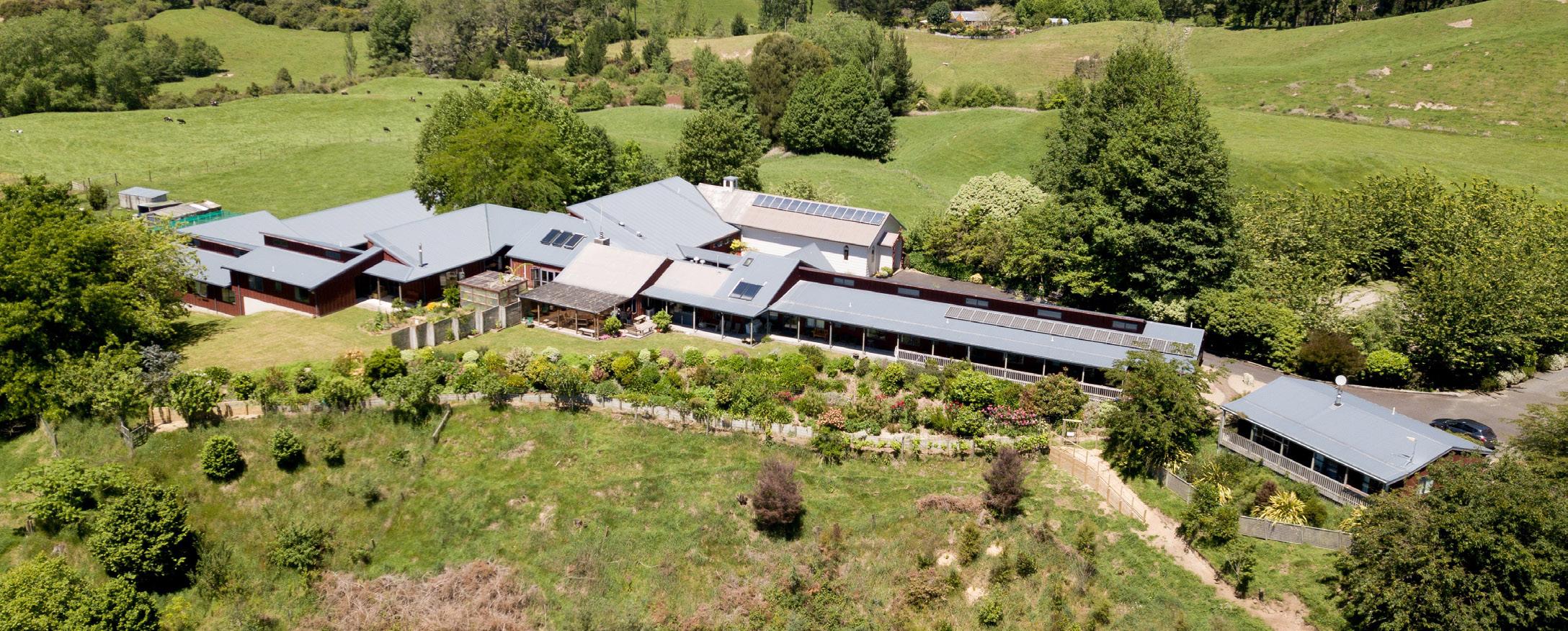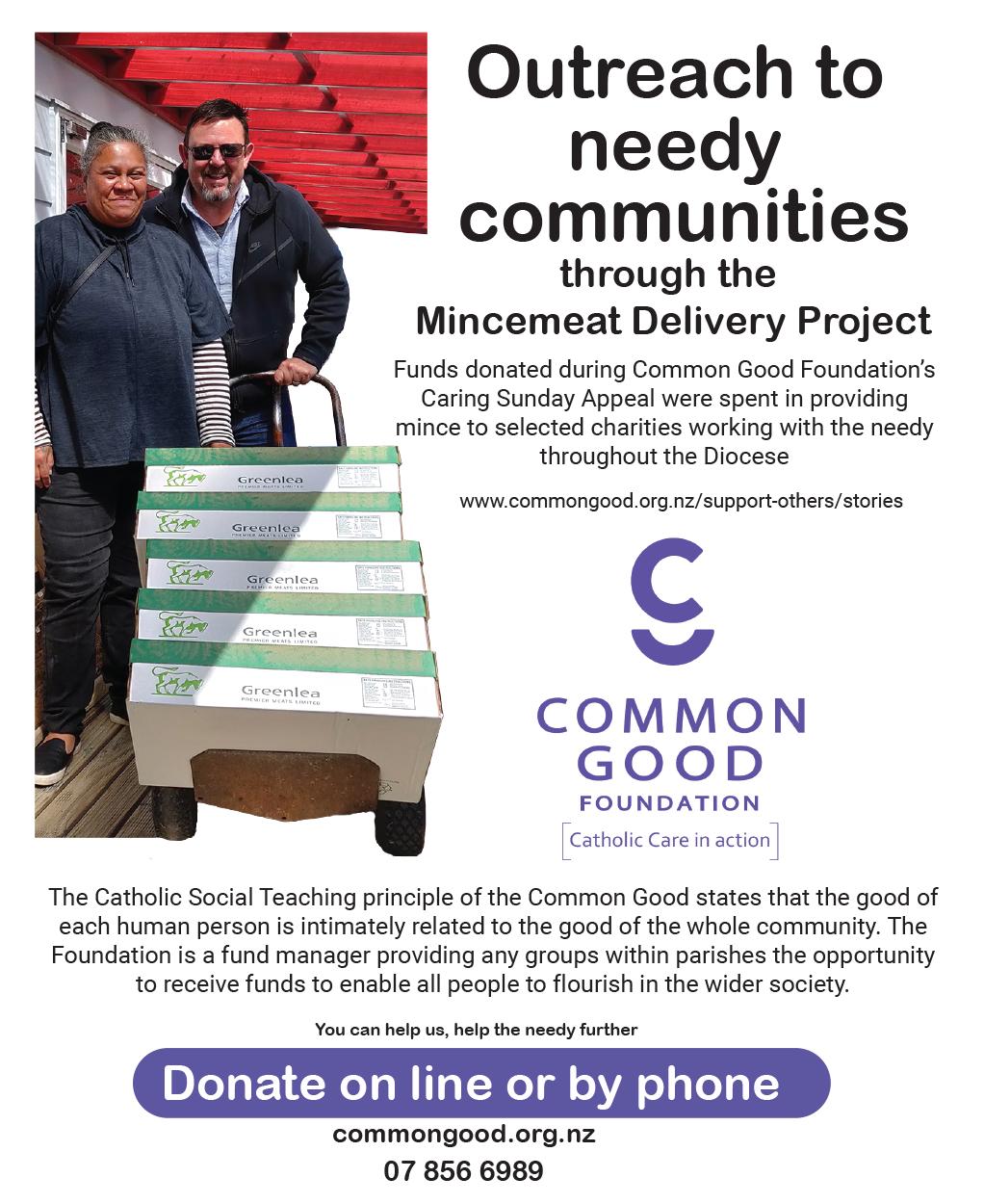
11 minute read
A CALLING TO DO SOMETHING FOR GOD AND FOR THE WORLD
JO LINES-MACKENZIE
L-R: Mother Joanna, Mother Rachel and Mother Miriam Joseph.
Advertisement
Turning off the road and into a long tree lined driveway, a sign points the way to Tyburn Monastery. Underneath it is another offering further direction for the spiritually unsure - God’s Road, it reads. At the end is a property named Cor Iesu Fons Vitae, which is Latin for “Heart of Jesus, Fount of Life”.
There’s just one other car in the car park when Stuff pulls in to meet the nuns that run the property thirty minutes south of Rotorua in Ngakuru.
Only bird chatter breaks the silence when we step outside. A quick walk up the path and a ring of a doorbell brings a warm greeting from Mother Miriam Joseph, and introductions to Mother Superior Rachel and Mother Mary Joanna. Resplendent in black and white habits – handmade by the mothers themselves – in a world where nuns are no longer a common sight, the trio are the very picture of how a society that rarely sees nuns except in film and popular culture depictions would imagine them.
Over a cuppa and a plate of biscuits the three share their way of life for the next ninety minutes. We are settled into a comfortable lounge area which overlooks Lake Ohakuri. Although not quite an alpine lake, it’s not hard to imagine a scene from The Sound of Music taking place in the picturesque surroundings.
The Ngakuru property is the second Tyburn monastery in New Zealand, the other being in Bombay, on the border of Auckland and Waikato.
The Rotorua monastery was inaugurated in May 2009. It was established in response to an invitation from Bishop Denis Browne to establish a Tyburn Monastery in the Diocese of Hamilton.
Mother Rachel is the monastery’s mother superior. A diminutive figure, she arrived at the monastery in about 2014. She recently received New Zealand citizenship, her third, after hailing originally from Lebanon and then Australia.
None of the nuns will confirm their ages, as birthdays are not celebrated, but Mother Rachel entered the monastery about 30 years ago around the age of 31.
The pull had been strong before then. “I used to feel like I wanted to be a nun when I was young, and my mother used to pray for me to be a nun, but that didn’t happen. I had left school and was looking after my mother, my father had a shop and my mother used to help him, we had an orchard, but when she became sick I started helping him and looking after my mother. I was thinking of getting married and things like that, but luckily the Lord called me for other things.”
The monastery can cater for twenty nuns, however there are just four there at the moment. (Mother Mary Cecilia The Tyburn nuns are part of the Benedictine family, with the common name of their order referring to their mother monastery at Tyburn in London - the official name of the order is the Benedictine Adorers of the Sacred Heart of Jesus of Montmartre.
Nun numbers are dwindling, across all orders. [Editor - in fact, some orders are growing, with large numbers of vocations.] The Tyburn trio say people are still taking an interest in becoming a nun, but most of them pull out during the process before final vows.
That was never going to be the case for Mother Joanna, a self-confessed rebellious teenager. At 20, she was one year into a law degree when she became interested after her elder sister made the initial enquiries.
“She was just having a look around and in the end she didn’t join. She’s now married, but I did enter the monastery. It’s a calling and appeals to you, so you do something for God and for the world, it’s appealing in that sense I guess,” Mother Joanna said.
The process begins with a live-in stage, essentially where an enquirer can just have a look. If someone then wants to

join they become a postulate, wearing a short black veil and medal of the Sacred Heart. “Six months of that you can become a novice, you get a full habit and a white veil for two years.” A novice may request to make her first profession of Benedictine vows which are for three years. “After those three years you can pull out again but after you take your final vows you aren’t supposed to pull out,” explained Mother Joanna.
“Unfortunately these days people do, as with people not sticking in their marriages, they don’t stick in religious stuff either. But we have taken our final vows and hopefully we will be here for life.”
Mother Miriam Joseph is celebrating twelve months at the Rotorua Monastery. While also originally from Australia, she came to Rotorua via Largs in Scotland. She has been living the nun life for the past 22 years, having joined after turning 39, giving up a twelve-year career as a nurse.
It’s not a career for the ill-disciplined, with the nuns getting just two weeks off a year. That’s time away from their extra jobs around the monastery – not time off praying.
The women start their day at 5am. “Some get up exactly on the dot at five o’clock and no earlier. And then we start our prayers at 5.30am,” Mother Joanna said. The monastery chapel was donated by the diocese, coming on a truck from Taneatua.
“Most of our work is prayer, so we spend a lot of the day praying, and we fit in all our other work between that. There’s an hour-long prayer called nocturnes and all the prayer times are the traditional Benedictine prayers which are singing the psalms, and we get through 150 psalms every week and there is a Scripture reading and prayers,” Mother Joanna said.
After that if they have a bit of spare time someone will start cooking the dinner, then there are also the usual life administration tasks – accounts to be done, phone messages and emails to reply to.
There’s a difference though. This is all to be done in silence if possible, although with guests there are always questions to be answered.
Breakfast is at around 7.30am involving bread and a cup of tea. The nuns then have their community reunion. “This is our time to study anything that we need to or practice, read the Bible, read our rule or catechism, that is what we are doing at the moment,” Mother Miriam said. Mass comes after that, followed by the run of the devotional day – sext, none, vespers, compline –hours

marked in Latin and followed by thousands of their predecessors back to the dawn of Christianity. Lights out comes around 9pm.
The lack of new nuns is of concern for all three, as they don’t want to see their order and those like it dwindle out of existence.
“It’s just the way, I think all orders are the same really. Most of them are struggling at the moment, there is not that much faith in God anymore really,” Mother Joanna said.
The arrival of Covid-19 hasn’t helped matters and obtaining visas for potential arrivals is another problem. “A lot of our younger sisters are in Nigeria because the African countries are the ones which have a lot of faith, and they are the ones entering monasteries now. I think they [officialdom] are not so keen on Nigerian people, a lot of corruption, you would think a Catholic nun would be okay,” Mother Joanna said.
Previously a nun could go anywhere with no questions asked but nowadays they join the immigration queue and are treated no differently to anybody else.
A nun’s life isn’t for everyone, the trio admit. “A disciplined life is difficult I think for people,” Mother Rachel said. They understand that even though people might be genuinely good and religious they just can’t live that way of life. “We are not allowed radio or television unless it’s for some special event. We used to get the Guardian [newspaper] but that has gone so liberal for us nowadays, against what we believe, so we have stopped that.”
But technology has also brought their distant colleagues closer in some ways. “We have (messaging app) Whatsapp with all the congregations, which includes nine other countries, and the prioresses from those countries are continuously putting things on that is happening in their countries, so you do pick up a lot of information from that,” Mother Joanna said.
A common misconception is that an initiate couldn’t have been married before becoming a nun. “As long as you have [received a declaration of nullity] for your marriage by the Church, or you are a widow [it is allowed]. We have a widow actually, and she’s a grandmother, she entered when she was grandmother,” Mother Joanna said.
The nuns also have restrictions on how often they contact their family. “You don’t have a load of contact, once a month you can have a phone call or you can write to them. Sometimes if they’re from a long, long way away like Australia, they will come and stay for a week or

something but you don’t see them very often. We can’t go on holidays, we don’t get a day off,” Mother Joanna said. They also only venture off the property for necessities, like doctor or dentist appointments, but Mother Rachel and Mother Joanna both voted in the recent general elections.
“Exits from the monastery need the permission of the superior general, or they give Mother Prioress certain permissions, so she can allow us to go out for things like that.
Nuns are assigned to convents based on the mother general’s assessment of their skills and of the needs at a specific monastery. “She does ask you and if you had a real reason that she could understand, she will usually oblige. But usually they will just send you, and when you are young it’s great see the world,” Mother Joanna.
They get a lot of outside assistance with Rotorua locals delivering their supermarket shopping twice a week. While they lease most of their 12-hectare property to neighbours, the nuns do keep a couple of paddocks for their alpacas and small cows.
“We’ve got a gardener now. We didn’t for a long time, but he arrived last year because we are so few. Volunteers help out around the monastery, and we have the PD (community work) workers who mow the lawns on a Thursday,” Mother Joanna said.
The monastery is open to the public, with people visiting for a bush walk, a picnic by the lake or to stay in the guest rooms, which are very economical at $55 a night.
The guest house provides a large part of the monastery’s income, along with a small shop from which the nuns sell things they make, including candles and jam.
The Monastery gets an income but the nuns don’t. They don’t need it, they say, as they can’t go shopping. The sisters who are old enough to get a pension donate it to the monastery. Everything is held in common. If they need anything, they ask the mother superior, and she will provide.
There are eleven Tyburn monasteries in 10 countries. New Zealand has two, which is unusual, and the order is also in England, Ireland, Scotland, Australia, Ecuador, Colombia Peru, Italy and France.
The Mother General in London is in charge of all the monasteries with a prioress in each monastery next in charge.
For all three nuns, their families largely understood their decision to put on the habit every day. And that meant putting their original dreams to one side, with Mother Joanna leaving her law degree. “I hadn’t really thought about it, I was studying law because I enjoyed law in high school, so I did one year at university. It was interesting.”
Mother Miriam, who left nursing after twelve years, believes she would struggle to do the job now. “Nowadays with all the moral and ethical things that are going on in the world I wouldn’t like to be doing it. I sometimes feel we are praying for those suffering, especially with the euthanasia bill because people will feel obliged to do things that they wouldn’t do before the bill. “I loved the work when I was doing it but this is much better, much better. The best decision I ever made.”
As the nuns don’t get to choose where they get to go, they don’t get to choose which nuns they live with. “As in any family there will be blow ups occasionally, arguments, that is part of living a life of Christian charity - you forgive people, and forget. It’s the same as in a marriage, you have to get along with people and understand they’re different,” Mother Joanna.
A hot lunch and a walk through the property concludes the visit to the monastery. As we leave the nuns return to finish their daily routines and the silence descends again.
Originally published as “Sounds of Silence” in Waikato Times, in a slightly different form, on Jan 13 2021. Reprinted with permission. Photo credit: Stuff Limited














